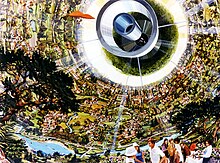
Space colonization is the use of outer space for colonization, such as permanent habitation, exploitation or territorial claims. Extraterrestrial colonization is its broader form, including the use of celestial bodies, other than Earth, for colonization.

Daylighting is the practice of placing windows, skylights, other openings, and reflective surfaces so that direct or indirect sunlight can provide effective internal lighting. Particular attention is given to daylighting while designing a building when the aim is to maximize visual comfort or to reduce energy use. Energy savings can be achieved from the reduced use of artificial (electric) lighting or from passive solar heating. Artificial lighting energy use can be reduced by simply installing fewer electric lights where daylight is present or by automatically dimming or switching off electric lights in response to the presence of daylight – a process known as daylight harvesting.

A space settlement is a more advanced form of habitation in outer space than a space station or habitation module, in that it is intended as a permanent settlement or green habitat rather than as a simple way-station or other specialized facility. No space settlement has been constructed yet, but many design concepts, with varying degrees of realism, have come both from engineers and from science-fiction authors.
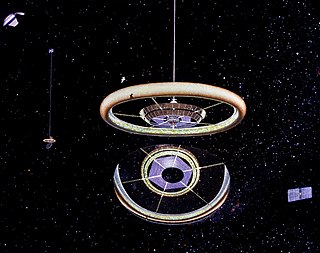
The Stanford torus is a proposed NASA design for a space settlement capable of housing 10,000 to 140,000 permanent residents.
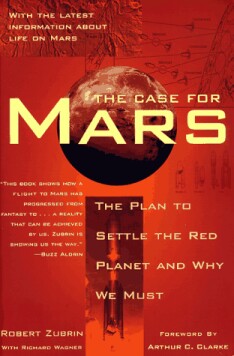
The Case for Mars: The Plan to Settle the Red Planet and Why We Must is a nonfiction science book by Robert Zubrin, first published in 1996, and revised and updated in 2011.

Mining the Sky: Untold Riches from the Asteroids, Comets, and Planets, is a 1997 book by University of Arizona Planetary Sciences professor emeritus John S. Lewis that describes possible routes for accessing extraterrestrial resources, either for use on Earth or for enabling space colonization. Each issue or proposal is evaluated for its effects on humanity, physics and economic feasibility based on planetary science. For instance, Chapter 5 exhaustively catalogs the types of near-Earth objects, assessing both the harms likely from possible collisions with Earth on the one hand, and their potential for profitable exploitation on the other.

Gerard Kitchen O'Neill was an American physicist and space activist. As a faculty member of Princeton University, he invented a device called the particle storage ring for high-energy physics experiments. Later, he invented a magnetic launcher called the mass driver. In the 1970s, he developed a plan to build human settlements in outer space, including a space habitat design known as the O'Neill cylinder. He founded the Space Studies Institute, an organization devoted to funding research into space manufacturing and colonization.

A megastructure is a very large artificial object, although the limits of precisely how large vary considerably. Some apply the term to any especially large or tall building. Some sources define a megastructure as an enormous self-supporting artificial construct. The products of megascale engineering or astroengineering are megastructures.
The L5 Society was founded in 1975 by Carolyn Meinel and Keith Henson to promote the space colony ideas of Gerard K. O'Neill.

The High Frontier: Human Colonies in Space is a 1976 book by Gerard K. O'Neill, a road map for what the United States might do in outer space after the Apollo program, the drive to place a human on the Moon and beyond. It envisions large human occupied habitats in the Earth-Moon system, especially near stable Lagrangian points. Three designs are proposed: Island one, Island two, and Island 3. These would be constructed using raw materials from the lunar surface launched into space using a mass driver and from near-Earth asteroids. The habitats were to spin for simulated gravity and be illuminated and powered by the Sun. Solar power satellites were proposed as a possible industry to support the habitats.

The concepts of space stations and space habitats feature in science fiction. The difference between the two is that habitats are larger and more complex structures intended as permanent homes for substantial populations, but the line between the two is fuzzy with significant overlap and the term space station is sometimes used for both concepts. The first such artificial satellite in fiction was Edward Everett Hale's "The Brick Moon" in 1869, a sphere of bricks 61 meters across accidentally launched into orbit around the Earth with people still onboard.
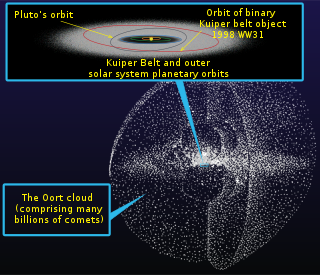
Freeman Dyson proposed that trans-Neptunian objects, rather than planets, are the major potential habitat of life in space. Several hundred billion to trillion comet-like ice-rich bodies exist outside the orbit of Neptune, in the Kuiper belt and Inner and Outer Oort cloud. These may contain all the ingredients for life, including significant amounts of deuterium and helium-3. Since Dyson's proposal, the number of trans-Neptunian objects known has increased greatly.

Lagrange point colonization is a proposed form of space colonization of the five equilibrium points in the orbit of a planet or its primary moon, called Lagrange points.
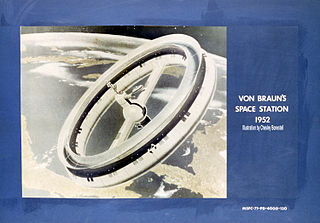
A rotating wheel space station, also known as a von Braun wheel, is a concept for a hypothetical wheel-shaped space station. Originally proposed by Konstantin Tsiolkovsky in 1903, the idea was expanded by Herman Potočnik in 1929.

2081: A Hopeful View of the Human Future is a 1981 book by Princeton physicist Gerard K. O'Neill. The book is an attempt to predict the social and technological state of humanity 100 years in the future. O'Neill's positive attitude towards both technology and human potential distinguished this book from gloomy predictions of a Malthusian catastrophe by contemporary scientists. Paul R. Ehrlich wrote in 1968 in The Population Bomb, "in the 1970s and 1980s hundreds of millions of people will starve to death". The Club of Rome's 1972 Limits to Growth predicted a catastrophic end to the Industrial Revolution within 100 years from resource exhaustion and pollution.
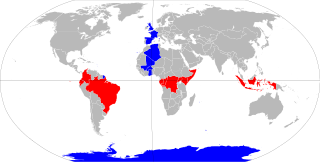
The equator is a circle of latitude that divides a spheroid, such as Earth, into the Northern and Southern hemispheres. On Earth, the Equator is an imaginary line located at 0 degrees latitude, about 40,075 km (24,901 mi) in circumference, halfway between the North and South poles. The term can also be used for any other celestial body that is roughly spherical.
A Bishop Ring is a type of hypothetical rotating space habitat originally proposed in 1997 by Forrest Bishop of the Institute of Atomic-Scale Engineering. The concept is a smaller scale version of the Banks Orbital, which itself is a smaller version of the Niven ring. Like other space habitat designs, the Bishop Ring would spin to produce artificial gravity by way of centrifugal force. The design differs from the classical designs produced in the 1970s by Gerard K. O'Neill and NASA in that it would use carbon nanotubes instead of steel, allowing the habitat to be built much larger. In the original proposal, the habitat would be approximately 1,000 km (620 mi) in radius and 500 km (310 mi) in width, containing 3 million square kilometers of living space, comparable to the area of Argentina or India.
A McKendree cylinder is a type of hypothetical rotating space habitat originally proposed at NASA's Turning Goals into Reality conference in 2000 by NASA engineer Tom McKendree. Like other space habitat designs, the cylinder would spin to produce artificial gravity by way of centrifugal force. The design differs from the classical designs produced in the 1970s by Gerard K. O'Neill and NASA in that it would use carbon nanotubes instead of steel, allowing the habitat to be built much larger. In the original proposal, the habitat would consist of a cylinder approximately 460 km (290 mi) in radius and 4,600 km (2,900 mi) in length, containing 13 million km2 (5 million sq mi) of living space, nearly as much land area as that of Russia.

An O'Neill cylinder is a space settlement concept proposed by American physicist Gerard K. O'Neill in his 1976 book The High Frontier: Human Colonies in Space. O'Neill proposed the colonization of space for the 21st century, using materials extracted from the Moon and later from asteroids.

A skylight is a light-permitting structure or window, usually made of transparent or translucent glass, that forms all or part of the roof space of a building for daylighting and ventilation purposes.

